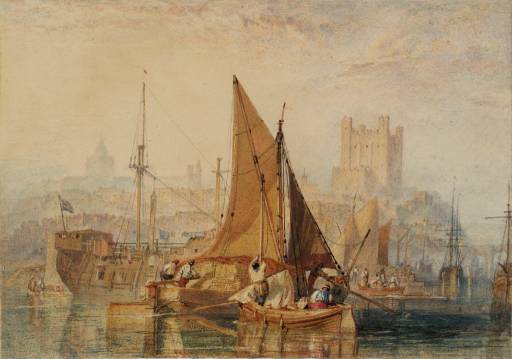Joseph Mallord William Turner Rochester, on the River Medway 1822
Joseph Mallord William Turner,
Rochester, on the River Medway
1822
Joseph Mallord William Turner 1775–1851
Rochester, on the River Medway 1822
D18156
Turner Bequest CCVIII W
Turner Bequest CCVIII W
Watercolour on paper, 152 x 219 mm
Watermark J Wh[atman] | Turke[y mill]
Blind-stamped with Turner Bequest monogram bottom left
Watermark J Wh[atman] | Turke[y mill]
Blind-stamped with Turner Bequest monogram bottom left
Accepted by the nation as part of the Turner Bequest 1856
Exhibition history
1904
National Gallery, London, various dates to at least 1904 (420).
1980
Turner at the Bankside Gallery: Drawings & Water-colours of British River Scenes from the British Museum, Bankside Gallery, London, November–December 1980 (55).
1983
J.M.W. Turner: Dibujos y acuarelas del Museo Británico, exhibition catalogue, Museo del Prado, Madrid, February–March 1983 (34 reproduced in colour p.54).
1984
J.M.W. Turner: Akvareller Målningar Grafik, Nationalmuseum, Stockholm, February–May 1984 (9).
1986
Turner Exhibition, National Museum of Western Art, Tokyo, August–October 1986, Municipal Museum of Art, Kyoto, October–November (75 reproduced in colour).
1988
Summer Miscellany: Watercolours from the Turner Bequest, Tate Gallery, London, July–October 1988 (no catalogue).
1989
[?] Turner & the Coast of Kent, Canterbury Festival, Canterbury City Museums, October 1989 (no catalogue entries or list of works).
1991
Turner: The Fourth Decade: Watercolours 1820–1830, Tate Gallery, London, January–May 1991 (11).
2001
Turner and Kent, Royal Museum & Art Gallery, Canterbury, September/October–November 2001, (exhibits not listed in catalogue, pp.8–9 colour).
2005
Turner’s Picture of Britain, Clore Gallery, Tate Britain, London, June 2005–April 2006 (no catalogue).
2009
Water Colours: From the Source to the Sea, Tate Britain, London, August 2009–July 2010 (no catalogue).
References
1904
E.T. Cook and Alexander Wedderburn (eds.), Library Edition: The Works of John Ruskin: Volume XIII: Turner: The Harbours of England; Catalogues and Notes, London 1904, p.282, no.123, as ‘Rochester’.
1909
A.J. Finberg, A Complete Inventory of the Drawings of the Turner Bequest, London 1909, vol.II, p.631, CCVIII W, as ‘Rochester, on the River Medway’.
1990
Eric Shanes, Turner’s England 1810–38, London 1990, p. 105, no.80 (colour).
1991
Ian Warrell, Turner: The Fourth Decade: Watercolours 1820–1830, exhibition catalogue, Tate Gallery, London 1991, p.31, no.11 reproduced.
1996
Julius Bryant, Turner: Painting the Nation: English Heritage Properties as Seen by J.M.W. Turner, London 1996, p.34.
This watercolour is based on drawings in the Medway sketchbook of 1820 (Tate D17394–D17396; Turner Bequest CXCIX 18–19a). The most significant elements of these sketches are contracted to produce the view for the present finished watercolour.1
Turner virtually obscures the town with the depiction of river shipping. The fleet of craft includes a hay-carrying Thames barge and a prison hulk interspersed with sailboats, ketches, and other light craft. The striking angles in the isosceles form of the foreground sail is echoed in the background where rectilinear lines of ship masts and rigging and more triangular peaks of sails, some taut and some slack, give an impression of bustle and passage. The twelfth-century castle, looking ‘even more foursquare by comparison’, can be seen in the distance dominating the skyline atop a chalk cliff.2
On the left, cloaked in a heavy morning mist, is Rochester Cathedral. Founded by St Augustine in 604, the present Norman building dates from 1077.3 These features are bathed in pale pink and gold ethereal light; the gold colouration strengthening in the foreground to become the dominant hue for the shipping. Though these monuments offer picturesque and historic incident, it is clear that Turner’s focus here is life and labour on the Medway. The picture becomes markedly more focused in the foreground, Turner rendering the details of the hulk’s architecture, the rigging and mast of the barge in fine emboldened line. The reflections in the placid River Medway are rendered with acuity. As with all the drawings in this series, the colouring is rich and complex, comprised of layered stipples and hatches of complementary and contrasting tones to achieve a striking prismatic effect. This is particularly apparent in the rendering of the sky, river, and of the monuments in the background.
Turner made his first visit to Rochester in 1793, when he was eighteen, to produce his earliest recorded oil painting: a view of the town with fishermen drawing boats ashore in a gale. The location of this work has been untraceable since 1860.4 For Turner’s drawings of Rochester dating between 1793 and 1794, see Tate D00117, D00159, D00160; Turner Bequest VIII C, XV C, D. There is also a finished watercolour of 1795 depicting a panoramic view of the city (Manchester City Galleries).5 For other sketches and studies of Rochester see the River and Margate sketchbook of about 1805–9 (Tate D06447, D06449, D06450, D06480, D06482; Turner Bequest XCIX 29, 53a, 54, 69a, 70a). See also the Folkestone sketchbook of about 1821 (Tate D17217–D17219, D17223, D17303, D17304, D17342–D17346, D17350; Turner Bequest CXCVIII 6a, 7, 7a, 9a, 58a, 59, 79a–81a, 83a).
This drawing was engraved in mezzotint by Thomas Lupton and published in 1824 (Tate impressions T06370, T04796–T04798).
Verso:
Stamped in black with Turner Bequest monogram at centre and with ‘CCVIII W’ at centre towards top; inscribed in pencil ‘W’ ad ‘49’ towards top right.
Alice Rylance-Watson
March 2013
How to cite
Alice Rylance-Watson, ‘Rochester, on the River Medway 1822 by Joseph Mallord William Turner’, catalogue entry, March 2013, in David Blayney Brown (ed.), J.M.W. Turner: Sketchbooks, Drawings and Watercolours, Tate Research Publication, August 2014, https://www

